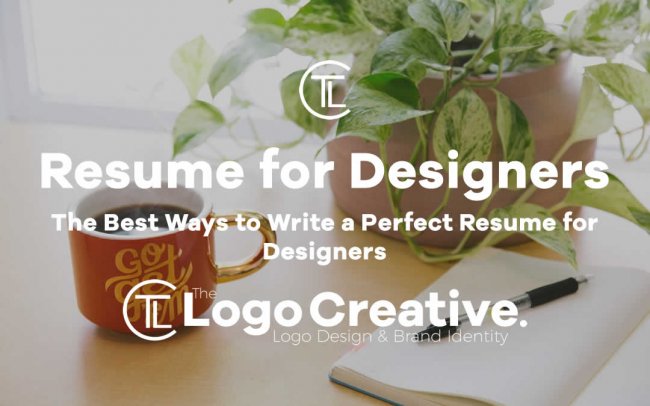Between jobs with a historically bad turnover, underpaying positions and terrible working conditions to boot, getting employed at a position with high job satisfaction is notoriously hard. Most of the great jobs out there have fierce competition, too. Join us in this article as we discuss The Best Ways to Write a Perfect Resume for Designers.
A lot of designers can’t work directly with clients, either, because the experience tends to be more agonizing than it is beneficial. Let alone the fact that getting the clients, to begin with, is an uphill task.
The only real way you can stand out from the rest of the crowd when job hunting is to put your best foot forward. You need a perfect resume.
Table of Contents
Drop the Word Processor
Most people’s first instinct when the mere mention of the word ‘CV’ or ‘resume’ comes up is to fire up Microsoft Word or Google Docs and start working with a template. As you might be well aware, though, these have a ton of downsides which are not very easy to get around.
For instance, if you use a font they haven’t installed, it will fall back to uglier fonts and some characters might not even show up. And, let’s face it, there’s no way in the world a word processor can provide the same kind of customizations a graphics editor can.
When it comes to design positions, hiring managers pay attention to the layout and presentation of your work just as much as the content.
Drop the word processor and use Illustrator, InDesign, Sketch or the millions of other quality graphics design software that are available online. Don’t forget to export it as a PDF before you mail it since it’s cross-platform and the text won’t be all jumbled up if they don’t have it in their system.
Be Brief
At the base level, a resume should summarize who you are, where you’ve worked before, what you’ve accomplished and what you expect from the future. Hiring managers also tend to pay attention to how good your grasp of the language is, especially in cases where you’re not a native speaker.
A lot of times, it is necessary. The resume should fit on a single side of A4-sized printing paper. If absolutely necessary, it should be two pages long. Longer resumes are usually thought to be trying to hide an unfortunately short ‘experience’ section with verbosity.
Always Have a Cover Letter
There is a lot of conflicting advice regarding cover letters online, mostly due to the different approaches people take to hiring a potential candidate. Going by career expert advice, you should almost always send in a cover letter, even if you believe nobody is going to read it.
A well-written cover letter serves the purpose of helping you stand out from the rest of the crowd. You are supposed to make an impression on a prospective employer by demonstrating what more you have to offer if hired for the position.
The resume itself is supposed to showcase your education and experience, but a cover letter tells the employer why they should hire you. They should highlight specific experiences that will make your bid stronger and even show off a bit about your personality.
Lastly, they provide a convenient way to address concerns the employer may have about your application. For instance, a gap year in your studies or employment is usually a big flag. A cover letter will offer you the opportunity to explain such irregularities.
In our experience, though, designers and copywriters have never been able to have their roles turned around. Despite presenting yourself as a hard worker for having gone the extra mile, your choice of words plays a vital role in whether they put you in consideration or not.
Don’t Forget Your Contact Information
This might sound like it would need nothing more than common sense to realize, but you wouldn’t believe the number of people that forget to include their contacts.
At a minimum, it should have your phone number and email address. Don’t assume that they will get back to you because you sent them an email, they have yours and can get back to you.
The contact section presents you with an opportunity to be able to stand out from the throngs of resumes the company receives, too. Include a link to your portfolio website, which should be just as well as your resume itself. If you’re yet to get down to having a website of your own, a link to your Behance, Dribbble or Artstation profile.
Include Samples of Your Past Work
Another mistake you may find yourself making is not including samples of your work. Many assume that since they have already linked their personal design profile sites, there’s no need to attach their work.
Thinking a hiring manager is going to go through the trouble of going through your site amidst a barrage of portfolios from every angle is a very brave assumption. An even worse strategy would be to include a list of big-name clients you’ve worked within the text and hope that they are going to stumble into it.
Depending on your layout, have a section dedicated to listing these clients and what you did with/for them – let your best achievements pop out. A lot of recruitment managers scan the text looking for information that will draw their eye rather than read through everything.
With that said, don’t overdo it. Save fancy mockups and images of your work for your website. You don’t necessarily have to attach these, but it depends on the company. If they require samples of your work, so be it.
Don’t Be Afraid to Ask For Help
Finally, don’t be afraid to look for outside help if you’re unsure of what to do next. Starting the resume is usually an interesting challenge for most people, but the cover letter ends up being where it all blows up. Ask a friend or family member to read over what you have written as a second pair of eyes that can spot simple mistakes and help with rewording certain paragraphs.
If you have no one to turn to, there are a lot of professional services out there that have a decent reputation that offer services like help with cover letter writing and resume writing.
Conclusion
Design can be one of the most satisfying careers anyone ever picks for themselves, as long as you land a job with high satisfaction. The best way to do this is to have a good resume and stand out. We hope you have enjoyed this article about The Best Ways to Write a Perfect Resume for Designers.
Useful Links & Great Deals
- The Equipment We Use & Recommend
- Quality Design Bundles
- Get 2 Months free Skillshare
- Get an Exclusive 20% off Logo Package Express
- Learn Logo Design Online
 Author Bio
Author Bio
Lilian Chifley works as an EssayMama. She also works as an Australian essays writer. She loves shopping, spending time with family.


